CoStar Composite Price Index Shows Slow, Steady Growth In Third Quarter Even As Pricing Trends For General Commercial And Investment Grade Property Continue To Diverge
CCRSI RELEASE – OCTOBER 2017
(With data through SEPTEMBER 2017)
Print Release (PDF)
Complete CCRSI data set accompanying this release
This month's CoStar Commercial Repeat Sale Indices (CCRSI) provides the market's first look at commercial real estate pricing trends through September 2017. Based on 944 repeat sale pairs in September 2017 and more than 183,000 repeat sales since 1996, the CCRSI offers the broadest measure of commercial real estate repeat sales activity.
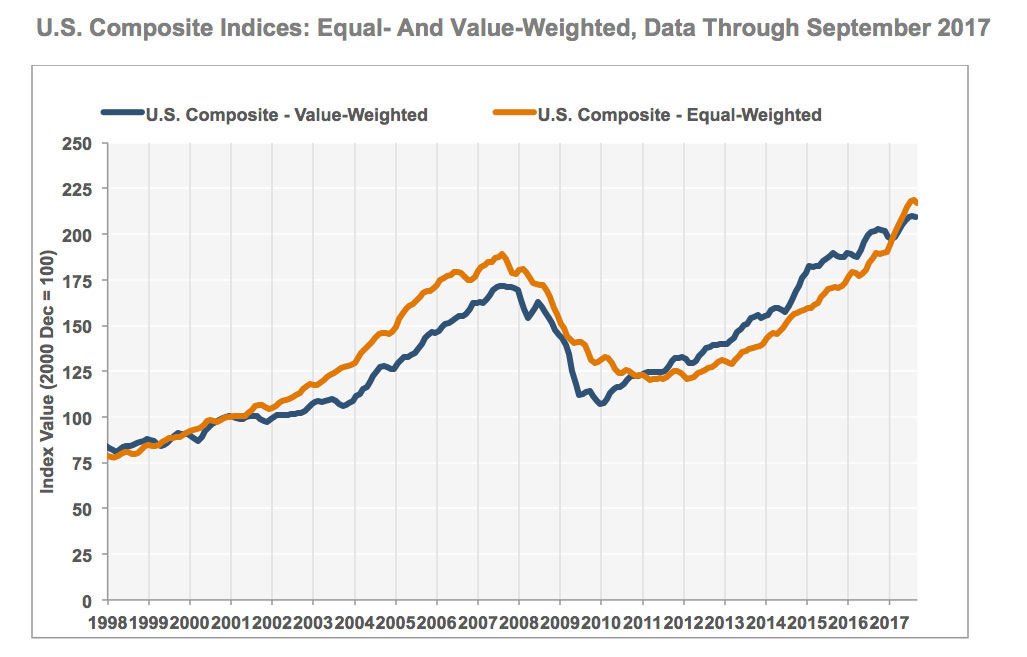
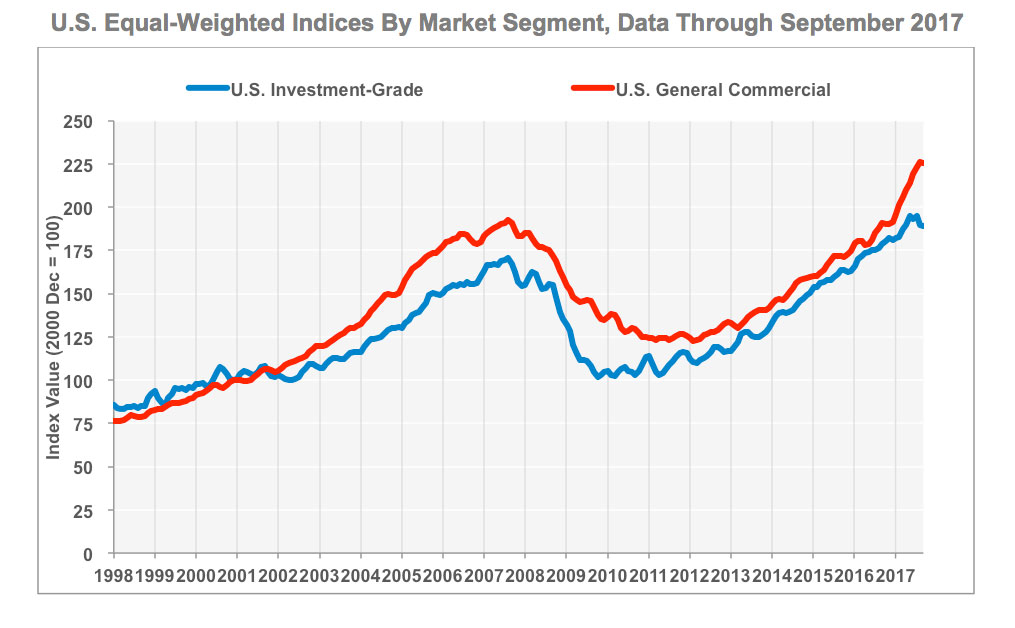
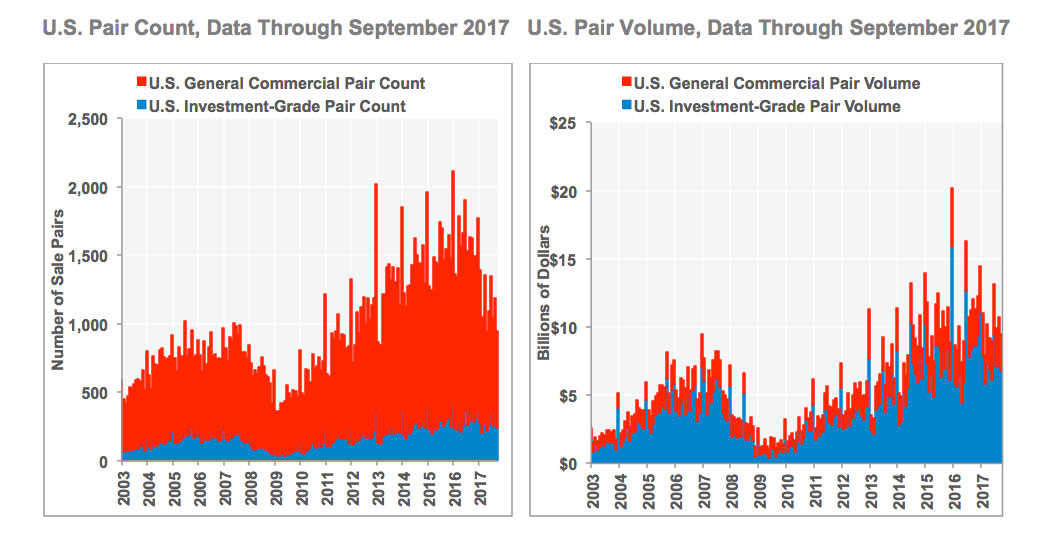
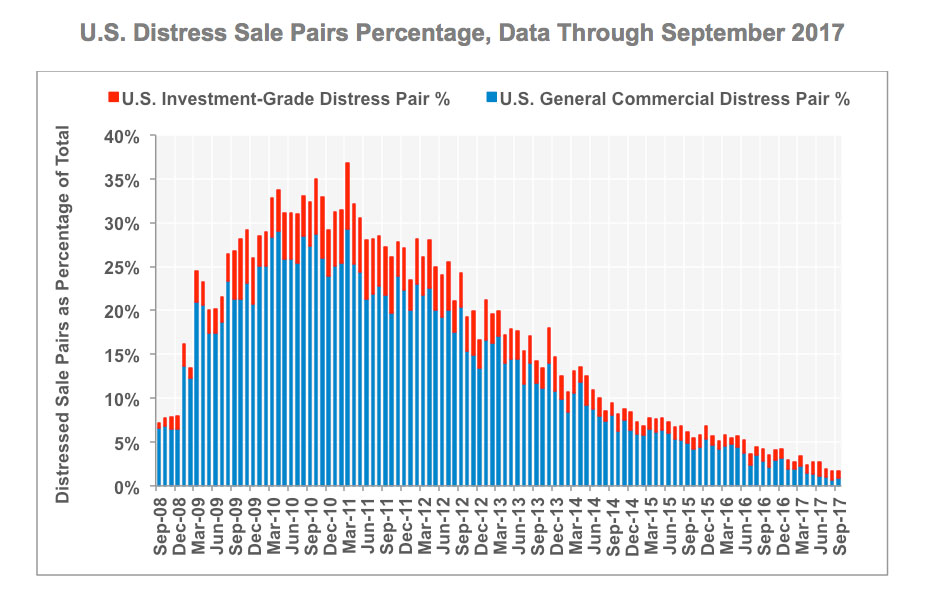
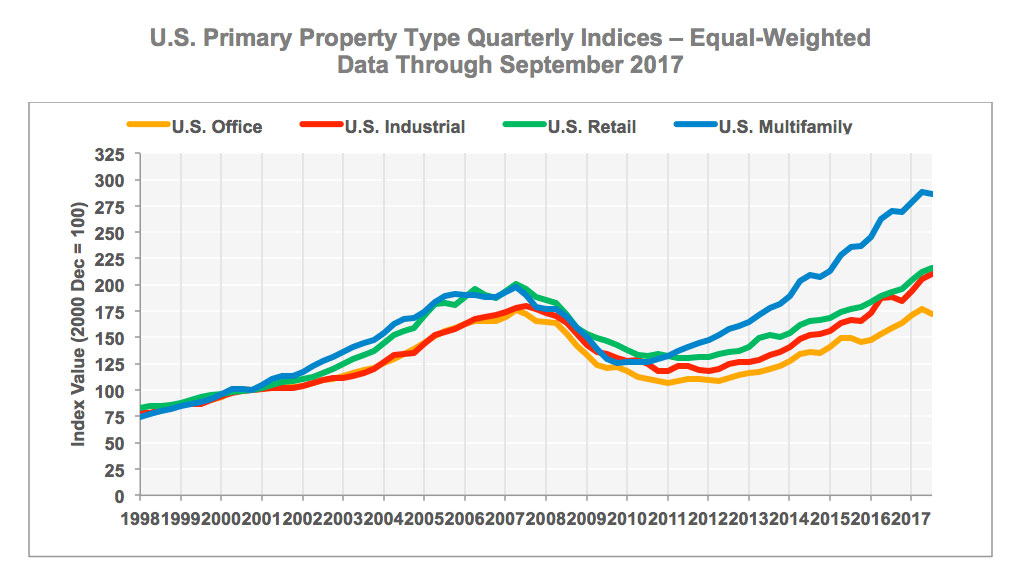
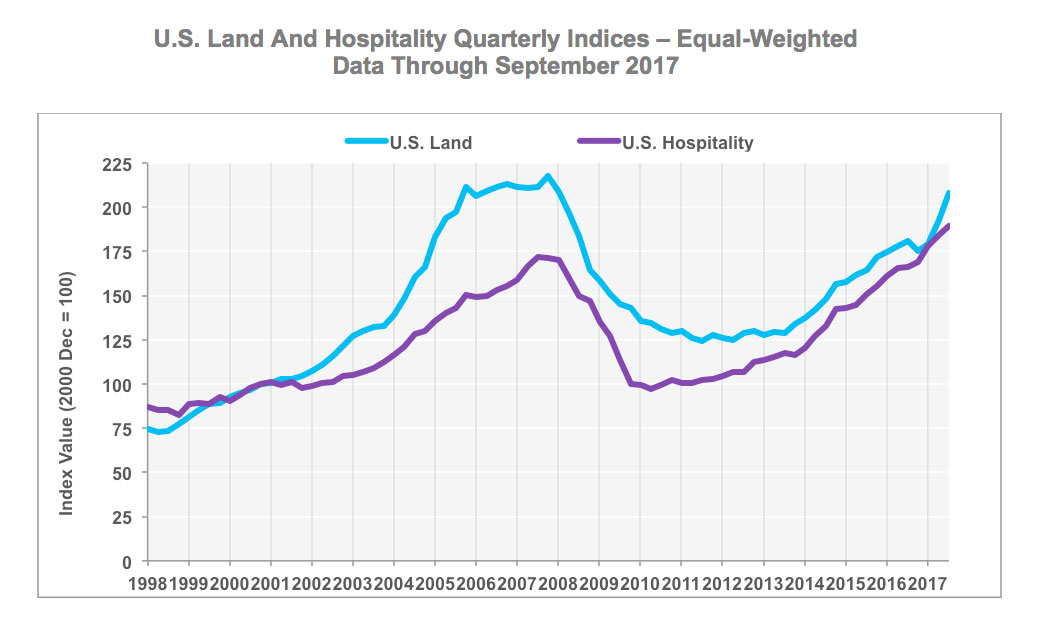
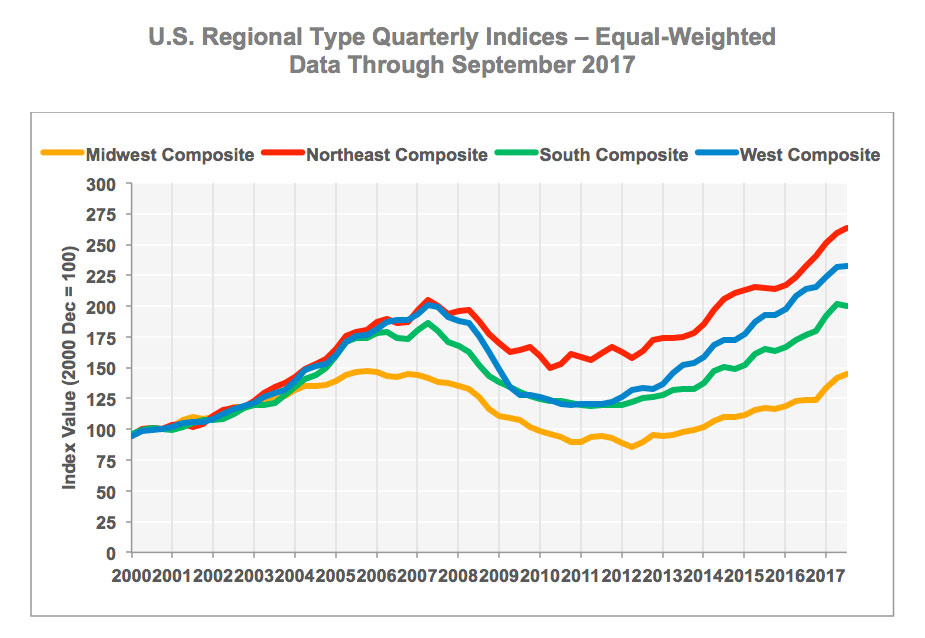

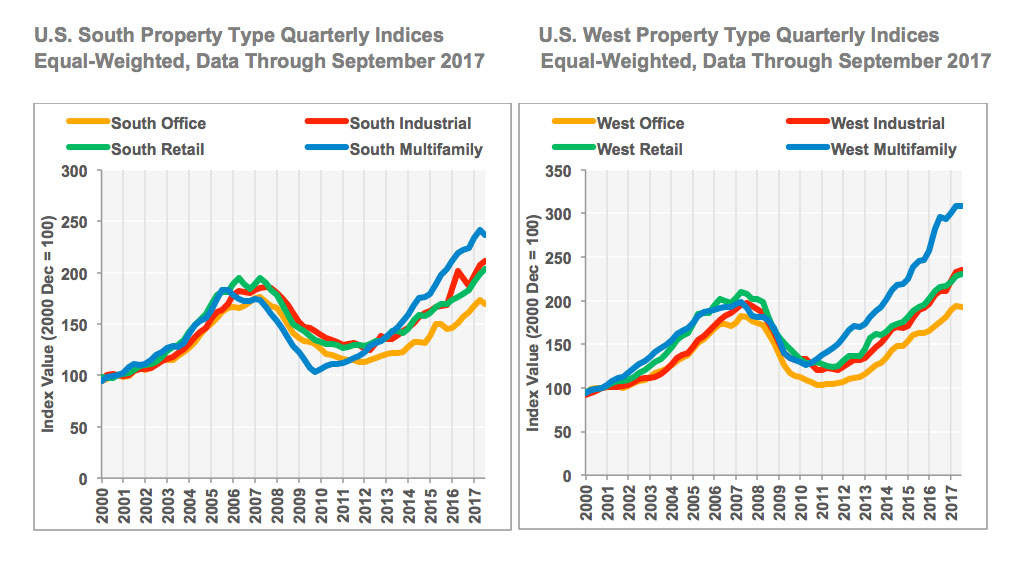
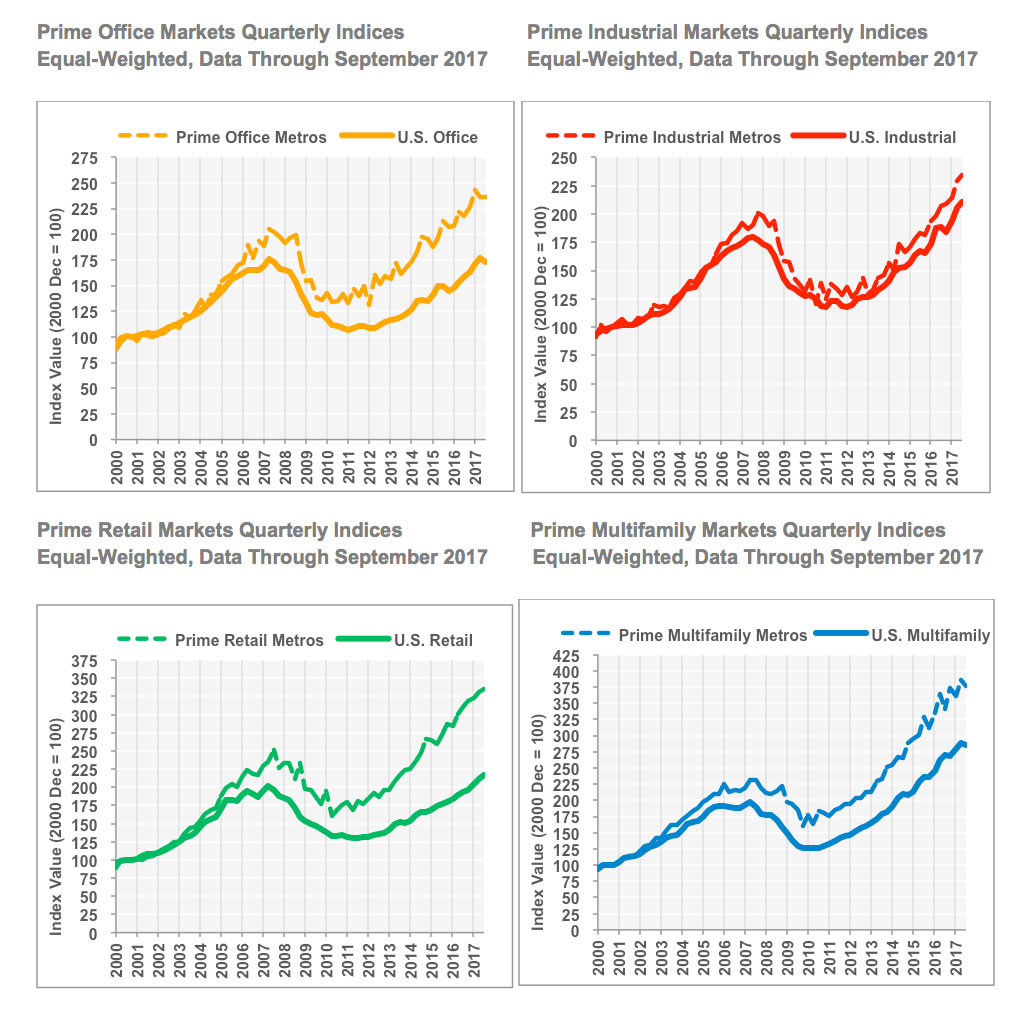
CCRSI National Results Highlights
-
COMPOSITE PRICE INDICES POST SLOWER GROWTH RATE IN THIRD QUARTER. The equal-weighted U.S. Composite Index continued to increase in the third quarter of 2017. However, the quarterly increase of 1.2% was well off the more than 4% average quarterly growth in the equal-weighted U.S. Composite Index over the preceding four quarters. While overall trends in the equal-weighted U.S. Composite Index appear very healthy with an annual gain of 14.7% for the 12-month period ended in September 2017, the value-weighted U.S. Composite Index advanced by just 0.9% in the third quarter of 2017, down from an average 1.5% quarterly growth in the previous four quarters. Recent movement in the value-weighted Composite Index contributed to a solid annual gain of 4.1% in the 12-month period ended in September 2017.
-
PRICING MOMENTUM REMAINS STRONGER IN LOWER END OF MARKET. The divergence in price growth in the composite indices continued to be reflected in the two sub-indices of the equal-weighted Composite Index. The General Commercial segment, which is influenced by smaller, lower-priced properties, increased 18.1% in the 12-month period ended in September 2017, one of the highest annual percent gains on record for the index. Meanwhile, the Investment-Grade Index, which is influenced by higher-value properties, rose by 6.0% in the 12-month period ended in September 2017. The recent momentum and increases in the General Commercial segment demonstrates the breadth of the pricing recovery.
-
U.S. LAND AND HOSPITALITY INDICES LED GROWTH AMONG SIX MAJOR PROPERY TYPES. The U.S. Land Index advanced 15% over the last year, driven by strong interest from developers, while the U.S. Hospitality Index which tracks the sale of hotel properties, advanced by 13.7% in the 12-month period ended in September 2017.
-
MIDWEST REGIONAL INDEX FINALLY CLOSES IN ON PRERECESSION PEAK LEVEL. Price growth in all four of CCRSI’s regional indices advanced by a healthy margin in the 12-month period ended in September 2017. The Midwest, South and Northeast indices posted double digit growth over the last year, while the West Index lagged slightly, with an increase of 8.7% in the 12-month period ended in September 2017. Meanwhile the Midwest regional index, which has lagged the other regions throughout this cycle, rose to within 1% of its prerecession high in September 2017, another indicator of investors seeking out properties in lower-priced markets.
-
TRANSACTION VOLUME CONTINUED TO LEVEL OFF. Composite pair volume of $128.7 billion in the 12-month period ended in September 2017 was down 4.3% from the 12-month period ended in September 2016. This suggests that the moderation in transaction activity that began in 2016 from 2015 record levels is continuing in 2017.
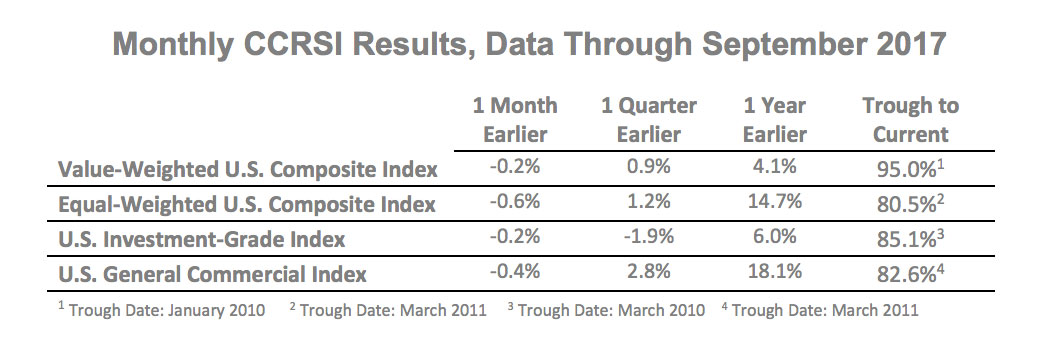
Quarterly CCRSI Property Type Results
-
HEALTHY PRICING GAINS SEEN ACROSS ALL SIX PROPERTY TYPE INDICES. While the Land and Hospitality indices posted the strongest price growth in the 12-month period ended in September of 2017 with increases of 15% and 13.7% respectively, price growth among the four major property types were not far behind, averaging 10% price growth in the same time period.
-
U.S. LAND INDEX CONTINUED TO MAKE STRONG GAINS THROUGH THE THIRD QUARTER. Boosted by strong demand for development sites across property types, the U.S. Land index gained 15% in the 12-month period ended in September 2017. With these healthy recent gains, the Land Index, which did not reach its trough for this cycle until 2012, has now come within 4.4% of its prerecession peak.
-
U.S. HOSPITALITY INDEX POSTED SECOND-STRONGEST GROWTH RATE AMONG ALL SIX PROPERTY INDICES. The U.S. Hospitality Index rose 13.7% during the 12-month period ended in September 2017 and has now surpassed its prior peak level reached in 2007 by 10.2%. National hotel occupancies remain well above last cycle’s highs, which has supported room rate and RevPAR growth as well as investor demand.
-
U.S. INDUSTRIAL INDEX GROWTH HOLDS STEADY IN THIRD QUARTER. While this year may prove to be the peak development year for industrial property this cycle, investor demand for warehouse and distribution facilities continued to accelerate through the third quarter of 2017, helping to prevent any significant supply-driven vacancy expansion. With market fundamentals in solid shape, the U.S. Industrial index advanced 11.5% in the 12-month period ended in September 2017. Core industrial markets remained in favor as the Prime Industrial Metros Index advanced by an even stronger 13.2% in the 12-month period ended in September 2017.
-
OFFICE INDEX GROWTH MODERATES. The U.S. Office index increased 8.7% in the 12-month period ended in September 2017, as national office occupancies and rents continued to hover near cyclical highs. Price growth in the Prime Office Metros Index advanced by a similar 8.2% rate in the 12-month period ended in September 2017 indicating similar pricing patterns across major and secondary markets.
-
MULTIFAMILY INDEX POSTS WEAKEST GROWTH AMONG PROPERTY TYPES THROUGH THE THIRD QUARTER. The U.S. Multifamily Index continued to increase but at the slowest rate among the major property type indices, expanding by 5.9% in the 12-month period ended in September 2017. The concentrated supply of new luxury apartments in urban locations has increased rental competition for existing institutional product, which may be putting pricing pressure on the Multifamily Index. The Prime Multifamily Metros Index posted steadier gains of 10.5% in the 12-month period ended in September 2017.
-
DESPITE HEADWINDS FACING RETAIL SECTOR, U.S. RETAIL INDEX CONTINUED TO MAKE STEADY GAINS. Nationally, retailer comparable-store growth has stalled and store closures by retailers including Sears/Kmart and JCPenney, among others, continue to take effect on retail property pricing. However, retailers are disproportionately targeting their less-productive locations for closure, while demand for stronger-performing locations remains robust. As a result, the U.S. Retail Index rose 12.1% in the 12-month period ended in September 2017. The Prime Retail Metros Index advanced by a solid 7.8% in the 12 months ended in September 2017, suggesting core retail locations nationally remain in favor with investors.
Quarterly CCRSI Regional Results
-
STRONG GROWTH BRINGS MIDWEST INDEX WITHIN 1% OF ITS PREVIOUS PEAK LEVEL. As previously stated, the Midwest Regional Index has continued to lag behind the other regions in the recovery. However, recent gains of 17.5% in the 12-month period ended in September 2017 have brought it to within 1% of its previous high-water mark reached in 2006. The Midwest Office and Multifamily indices were the best performers in the region, expanding by 22.8% and 14.1%, respectively, in the 12-month period ended in September 2017.
-
SOUTH REMAINED HOT WITH GROWTH OF 13.3%. Of the four core property type sub-indices within the region, the South Retail Index led pricing growth, expanding 13.3% in the 12-month period ended in September 2017, while the South Industrial and Office indices advanced by 8.4% and 8.2%, respectively, during the same period. The region’s favorable demographics and more affordable pricing have provided it with momentum in price growth as the cycle has progressed. The South Composite Index now stands 7.3% above its prerecession peak.
-
INDUSTRIAL AND RETAIL INDICES LED GROWTH IN NORTHEAST REGION. The Northeast Composite Index advanced by a healthy 13.2% rate in the 12-month period ended in September 2017, pushing it 28.6% above its prerecession peak. The Northeast Industrial and Retail Indices led pricing growth in the region expanding 10.4% and 13%, respectively, in the 12-month period ended in September 2017. Meanwhile, the Northeast Multifamily and Office indices also posted steady growth of 8.3% and 6.2%, respectively, in the 12-month period ended in September 2017.
-
STRONG GROWTH IN INDUSTRIAL INDEX BOLSTERED WEST REGION. The West Composite Index advanced 8.7% in the 12-month period ended in September 2017. While all sectors contributed to recent growth, the West Industrial Index led the region, expanding by 11.3% in the 12-month period ended in September 2017. Meanwhile, the West Multifamily Index expanded at a slower rate of 4.1% in the 12-month period ended in September 2017.
-
Please note the aggregate region index is generated using data of multiple property types in addition to the four core property types of office, multifamily, retail and industrial.
About The CoStar Commercial Repeat-Sale Indices
The CoStar Commercial Repeat-Sale Indices (CCRSI) is the most comprehensive and accurate measure of commercial real estate prices in the United States. In addition to the national Composite Index (presented in both equal-weighted and value-weighted versions), national Investment-Grade Index, and national General Commercial Index, which we report monthly, we report quarterly on 30 sub-indices in the CoStar index family. The sub-indices include breakdowns by property sector (office, industrial, retail, multifamily, hospitality, and land), by region of the country (Northeast, South, Midwest, and West), by transaction size and quality (general commercial, investment-grade), and by market size (composite index of the prime market areas in the country).
The CoStar indices are constructed using a repeat sales methodology, widely considered the most accurate measure of price changes for real estate. This methodology measures the movement in the prices of commercial properties by collecting data on actual transaction prices. When a property is sold more than once, a sales pair is created. The prices from the first and second sales are then used to calculate price movement for the property. The aggregated price changes from all of the sales pairs are used to create a price index.
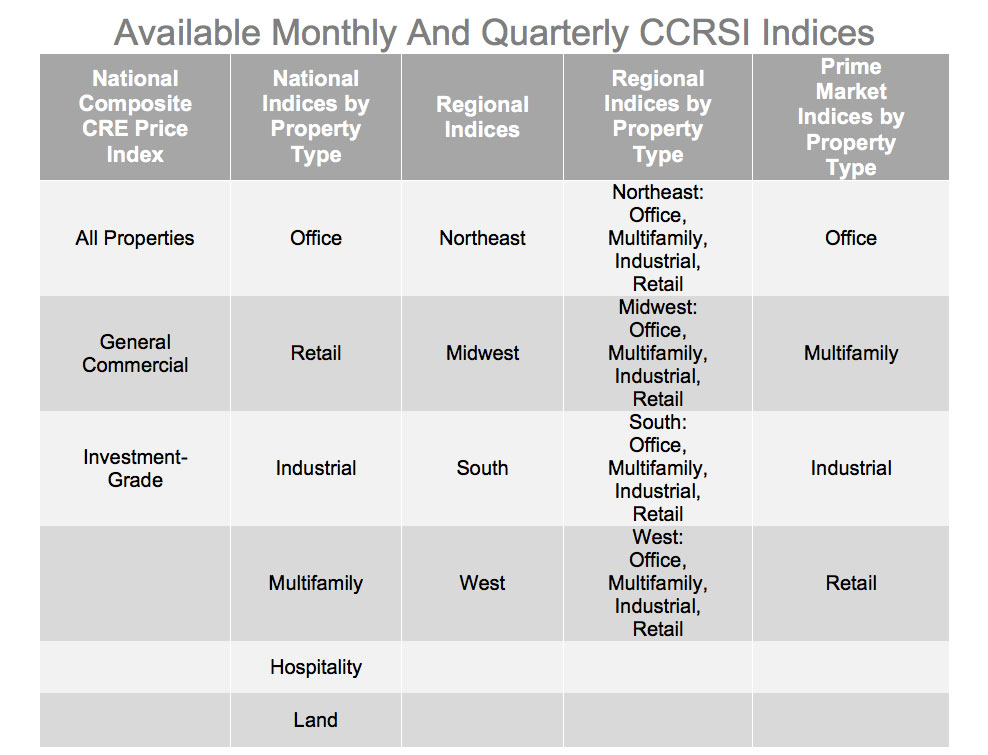
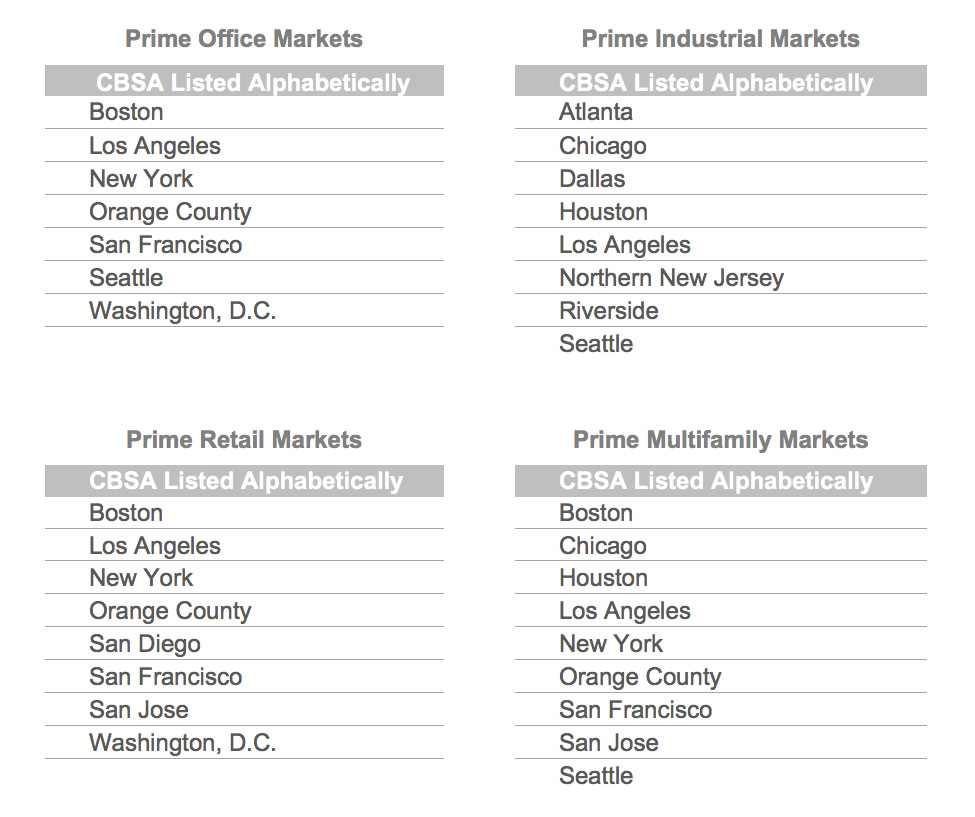
MEDIA Contact:
Gay Beach, Senior Director, Marketing Communications, CoStar Group (gbeach@costar.com).
For more information about the CCRSI Indices, including the full accompanying data set and research methodology, legal notices and disclaimer, please visit http://www.costargroup.com/costar-news/ccrsi.
About CoStar Group, Inc.
CoStar Group, Inc. (NASDAQ: CSGP) is the leading provider of commercial real estate information, analytics and online marketplaces. Founded in 1987, CoStar conducts expansive, ongoing research to produce and maintain the largest and most comprehensive database of commercial real estate information. Our suite of online services enables clients to analyze, interpret and gain unmatched insight on commercial property values, market conditions and current availabilities. LoopNet is the most heavily trafficked commercial real estate marketplace online with over 5 million monthly unique visitors per month. Apartments.com, ApartmentFinder.com, ApartmentHomeLiving.com, Westside Rentals and Apartamentos.com form the premier online apartment resource for renters seeking great apartment homes and provide property managers and owners a proven platform for marketing their properties. Through an exclusive partnership with Move, a subsidiary of News Corporation, Apartments.com is the exclusive provider of apartment community listings across Moves family of websites, which include realtor.com, doorsteps.com and move.com. CoStar Groups websites attracted an average of approximately 37 million unique monthly visitors in aggregate in the third quarter of 2017. Headquartered in Washington, DC, CoStar maintains offices throughout the U.S. and in Europe and Canada with a staff of over 3,600 worldwide, including the industry’s largest professional research organization. For more information, visit www.costargroup.com.
This news release includes "forward-looking statements" including, without limitation, statements regarding CoStar's expectations, beliefs, intentions or strategies regarding the future. These statements are based upon current beliefs and are subject to many risks and uncertainties that could cause actual results to differ materially from these statements. The following factors, among others, could cause or contribute to such differences: the risk that the trends represented or implied by the indices will not continue or produce the results suggested by such trends, including trends related to commercial real estate fundamentals, price growth and recovery, moderation in transaction activity; investor demand; and current demand for core retail locations nationally; the risk that investor behavior and demand changes; and the risk that transaction volume and commercial real estate pricing levels and growth will not continue at the levels or with the trends indicated in this release. More information about potential factors that could cause results to differ materially from those anticipated in the forward-looking statements include, but are not limited to, those stated in CoStar’s filings from time to time with the Securities and Exchange Commission, including in CoStar’s Annual Report on Form 10-K for the year ended December 31, 2016, and CoStar’s Quarterly Report on Form 10-Q for the quarter ended September 30, 2017, each of which is filed with the SEC, including in the “Risk Factors” section of those filings, as well as CoStar’s other filings with the SEC available at the SEC’s website (www.sec.gov). All forward-looking statements are based on information available to CoStar on the date hereof, and CoStar assumes no obligation to update or revise any forward-looking statements, whether as a result of new information, future events or otherwise.

